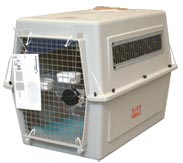Mascotas / Animales Vivos Estados Unidos (USA)
Mascotas / Animales Vivos
SERVICIO DISPONIBLE PROXIMAMENTE.
Pets
Documents Required
Rabies Vaccination Record
Veterinary Health Certificate
Specific Information
The importation of pets is subject to health, quarantine, agriculture or wildlife requirements and prohibitions.
Pets are subject to examination at the first port of arrival for any evidence of disease.
A valid Rabies (rage) Vaccination Record must accompany dogs arriving from areas not free from rabies.
There is no requirement for a rabies certificate for domestic cats.
Contact the destination agent to determine if special certificates and admission requirements apply, providing the common and scientific name of the animal along with the country of origin that it is being shipped to ensure all appropriate government agencies can be contacted.
Most turtles and monkeys are not allowed entry into the U.S.
Make sure you've chosen the right kennel for the animal being transported. All kennels must meet USDA guidelines or the International Air Transport Association (IATA) Live Animal Regulations.
Keep in mind that two dogs or two cats may share the same kennel if each is less than 20 lbs. and less than six months old. All animals must be at least eight weeks old and weaned.
Kennel Construction
Acceptable:
Kennels must be made from rigid plastic, metal or wood with a metal grated door.
Kennels must also be leak and escape proof, in good working condition and secured with metal nuts, bolts or screws (ensure screws are not exposed which may cause serious injury). Please note that it's common and acceptable for kennels to have nuts (or wingnuts) and bolts that are metal and covered with a plastic coating on the outside.
Kennels must have adequate ventilation on at least three sides for domestic routings, and on all four sides for international routings.
Kennels wheels, if any, must be rendered inoperable or removed completely.
Unacceptable:
Snap-sided kennels, modified or adapted snap-side kennels (including the addition of nuts, bolts or screws), collapsible or folding kennels.
Plastic and top-opening doors.
Kennel Interior
Kennel should be roomy enough for your pet to stand and sit erect without your pet's head (including ears) touching the top. Your pet must be able to stand, sit and lay as they normally would.
Two dishes (one for food and one for water) must be attached to the inside of the kennel. Dishes must be accessible from the outside without opening the door.
There must be enough food supplied for a 24 hour period.
Make sure the kennel is clean with no offensive odors.
Please place absorbent material along the bottom.
Not Acceptable: Hay, wood shavings or straw.
Kennel Exterior

In case there should be a delay, please tape a small bag of dry food to the top.
Place "Live Animal" and "This Side Up" labels (or directional arrows) on the top and at least two sides. The letters must be at least one inch tall.
Please attach a label with feeding and watering instructions, unless you have written instructions from an accredited veterinarian to not feed or water the animal.
Also, attach a note that states food and water was offered within four hours of the flight.
Extra Security
After the appropriate screening has been applied, releasable cable ties will be attached to all four corners of the kennel door. We will provide these ties at no cost. If you prefer, you may provide your own ties or sealing mechanisms, provided they can be removed prior to screening without the use of tools.
Tips for the Travelers
Buy the kennel beforehand so the animal can get used to it.
Bring a leash to the airport so that you can walk your pet before and after your flight.
Include ID tags with your name and number.
Never use choke collar or muzzle
Regulations are in place to protect your animals.
Make sure your animal meets applicable government regulations and complies with the U.S. Convention on International Trade in Endangered Species (CITES) Wild Fauna and Flora. Specific guidelines for the acceptance, care, handling and container requirements are published in the International Air Transport Association (IATA) Live Animal Regulations Manual. Unless there is a more restrictive policy, we adhere to the U.S. Department of Agriculture's (USDA's) Animal Plant and Health Inspection Service (APHIS) and the U.S. Fish & Wildlife Service (USFWS) guidelines in order to keep your animal as safe and comfortable as possible.
The information contained on this website is for general reference and guidance only. Please go to the USDA's APHIS website for detailed instructions and information.






